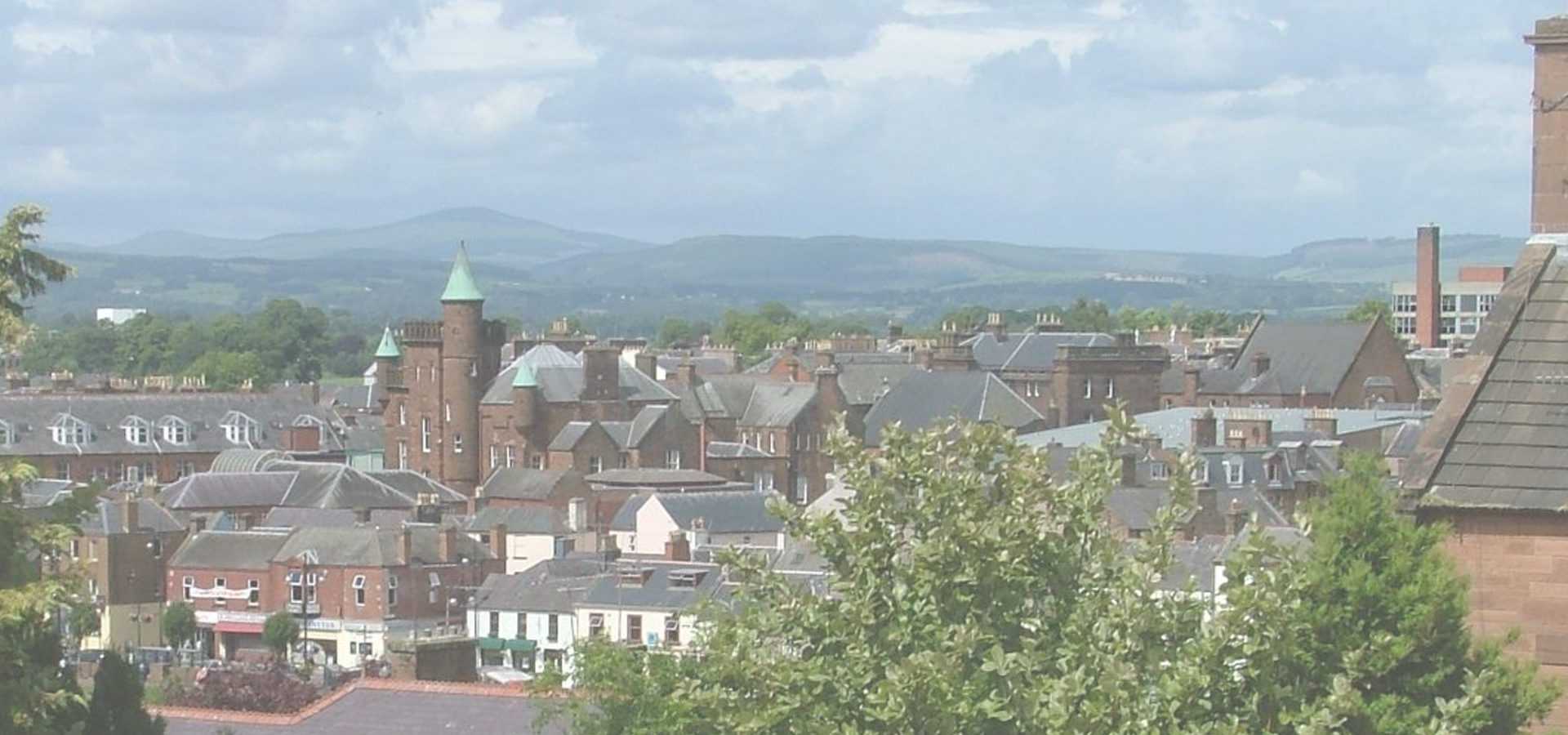🏴 Architect John Archibald Campbell is associated with Dumfries. He was elected a Fellow of the Royal Institute of British Architects (FRIBA) in 1906.
Dumfries, Dumfries and Galloway, Scotland, United Kingdom
🏴 Dumfries is a market town and former royal burgh within the Dumfries and Galloway council area of Scotland, UK. It is located near the mouth of the River Nith into the Solway Firth. Dumfries is the traditional county town of the historic county of Dumfriesshire.
Before becoming King of Scots, Robert the Bruce slew his rival the Red Comyn at Greyfriars Kirk in the town on 10 February 1306. The Young Pretender had his headquarters here during a 3-day sojourn in Dumfries towards the end of 1745. During the Second World War, the bulk of the Norwegian Army during their years in exile in Britain consisted of a brigade in Dumfries.
Dumfries is nicknamed Queen of the South. The nickname has also given name to the town's professional football club. People from Dumfries are known colloquially in Scots language as Doonhamers.
Economy Dumfries has a long history as a county town, and as the market town of a surrounding rural hinterland. The North British Rubber Company started manufacturing in 1946 at Heathhall on the former site of the Arrol-Johnston Motor Company which was said to be the most advanced light engineering factory of its day in Scotland. It became Uniroyal Ltd in the 1960s and was where the Hunter Boot and Powergrip engine timing belts were manufactured. In 1987 it changed name to the British subsidiary of the Gates Rubber Company and later was known as Interfloor from 2002 until the factory closed in 2013.
Dumfries is a relatively prosperous community but the town centre has been exposed to the centrifugal forces that have seen retail, business, educational, residential and other uses gravitate towards the town's urban fringe. This was started in the 1980s with the building of the Dumfries bypass. The immediate effect of this was as intended the diversion of transiting traffic away from the town centre. This brought with it an accompanying reduction in economic input to the town centre. The second effect of this has been more noticed. Sites close to the bypass have attracted development to utilise the bypass as a high speed urban highway without the bottlenecks of the town centre and without the constraining limited town centre parking.
In a bid to re-stimulate development in Dumfries town centre, both economically and in a social context, several strategies have been proposed by the controlling authorities.
Culture Dumfries got its nickname 'Queen of the South' from David Dunbar, a local poet, who in 1857 stood in the general election. In one of his addresses he called Dumfries "Queen of the South" and this became synonymous with the town.
The term doonhamer comes from the way that natives of Dumfries over the years have referred to the area when working away from home. The town is often referred to as doon hame in the Scots language (down home). The term doonhamer followed, to describe those that originate from Dumfries.
The Doonhamers is also the nickname of Queen of the South who represent Dumfries and the surrounding area in the Scottish Football League.
The crest of Dumfries contains the words, "A Lore Burne". In the history of Dumfries close to the town was the marsh through which ran the Loreburn whose name became the rallying cry of the town in times of attack – A Lore Burne (meaning 'to the muddy stream').
in 2017 Dumfries was ranked the happiest place in Scotland by Rightmove.
Dumfries, Dumfries and Galloway, Scotland, United Kingdom

Dumfries has a population of over 33,440 people. Dumfries also forms one of the centres of the wider Dumfries and Galloway district which has a population of over 148,790 people.
To set up a UBI Lab for Dumfries see: https://www.ubilabnetwork.org Twitter: https://twitter.com/UBILabNetwork
Twin Towns, Sister Cities Dumfries has links with:
🇺🇸 Annapolis, USA 🇮🇹 Cantù, Italy 🇩🇪 Gifhorn, Germany-
John Archibald Campbell |
-
Alexander Ross |
🏴 Architect Alexander (1834-1925) Ross is associated with Dumfries. He was elected a Fellow of the Royal Institute of British Architects (FRIBA) in 1893.
-
David Bateman Hutton |
🏴 Architect David Bateman Hutton is associated with Dumfries. He was elected a Fellow of the Royal Institute of British Architects (FRIBA) in 1915.
🇷🇺 Novosibirsk 55.05
🇷🇺 Novosibirsky District 55.017
🏴 North Tyneside 55.012
🏴 South Shields 54.983
🏴 Newcastle upon Tyne 54.979
🏴 Newton Abbot -3.61
🇪🇸 San Sebastián de los Reyes -3.617
🇪🇸 Alcobendas -3.644
🇪🇸 Gaztambide -3.7
🏴 Colwyn Bay -3.7
Locations Near: Dumfries -3.6031,55.071
🏴 Workington -3.555,54.637 d: 48.4
🏴 Whitehaven -3.586,54.548 d: 58.2
🏴 Carlisle -2.944,54.891 d: 46.6
🏴 Motherwell -3.985,55.784 d: 82.9
🏴 Livingston -3.516,55.883 d: 90.5
🏴 North Lanarkshire -3.922,55.829 d: 86.7
🏴 Hamilton -4.039,55.777 d: 83.2
🏴 East Kilbride -4.167,55.75 d: 83.5
Antipodal to: Dumfries 176.397,-55.071
🇳🇿 Dunedin 170.474,-45.884 d: 18911.8
🇳🇿 Invercargill 168.373,-46.413 d: 18900.6
🇳🇿 Christchurch 172.617,-43.517 d: 18701.9
🇳🇿 Canterbury 171.58,-43.543 d: 18687.3
🇳🇿 Queenstown 168.658,-45.033 d: 18771.4
🇳🇿 Wellington 174.767,-41.283 d: 18477.3
🇳🇿 Hutt 174.917,-41.217 d: 18470.7
🇳🇿 Lower Hutt 174.917,-41.217 d: 18470.7
🇳🇿 Upper Hutt 175.05,-41.133 d: 18462.1
